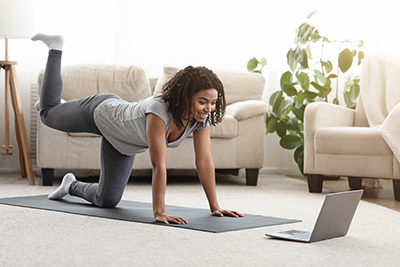 Many women wonder whether it's okay to work out during their period. The answer is easy: Yes! In fact, you may find that you can be more physically active and at greater intensity at certain times of the month than at other times.
Many women wonder whether it's okay to work out during their period. The answer is easy: Yes! In fact, you may find that you can be more physically active and at greater intensity at certain times of the month than at other times.
Does my energy level change during my period?
It might. Some women report low energy levels during their period, while other women have more energy than usual during this time. Changing hormone levels through the menstrual cycle may be the cause.
- Week 1: On the first day of your period, estrogen and progesterone levels are at their lowest. But they begin a gradual rise during your period. It may be easier to get active than in the previous weeks.
- Week 2: In the week after your period ends, your energy levels might begin to go up. Estrogen levels begin rising quickly in preparation for ovulation (releasing an egg from the ovary).
- Week 3: Estrogen levels peak around the time of ovulation, about two weeks before the next period for most women. When estrogen levels fall quickly after ovulation and progesterone levels begin rising, you may feel more tired or sluggish than usual. This does not mean that you should not exercise. In fact, being active might help boost your mood and give you more energy. Try exercising first thing in the morning, before your energy level goes down as the day goes on.
- Week 4: In the week before your next period, you may feel less energy as both estrogen and progesterone levels are falling (if you are not pregnant). Physical activity may help premenstrual symptoms (PMS) get better even if your energy levels are low.
Try keeping a fitness journal to track your menstrual cycle and your energy levels during each workout. After a few months, you should be able to see when you have more or less energy during your cycle.
If you take hormonal birth control, like the pill, patch, shot, or vaginal ring, your energy levels may still go up and down with your cycle, but the differences may not be as noticeable.
Does my menstrual cycle affect my ability to exercise?
No. Researchers have not been able to find any differences during the menstrual cycle in a woman’s ability to exercise. The only significant finding was for endurance events, or long sports events, like marathons. In endurance events, women who had already ovulated but not started their period yet had a harder time exercising during hot and humid weather.
Can exercise help menstrual cramps?
Maybe. Researchers have found that some women have fewer painful cramps during menstruation if they exercise regularly. There are over-the-counter medicines for menstrual cramps or pain that work well with very few risks. There are almost no risks to regular physical activity, like walking, which may also help you feel better during your period.
What if I'm working out a lot and I don't get my period?
Exercising too much can cause missed menstrual periods or make your periods stop entirely. Irregular or missed periods are more common in athletes and other women who train hard regularly. But if you haven’t worked out in a long time and suddenly start a vigorous fitness routine, your period could stop or become irregular.
Talk to your doctor or nurse if you have irregular or missed periods. A regular period is a sign of good health. These period problems can lead to more serious health problems, including problems getting pregnant and loss of bone density.
